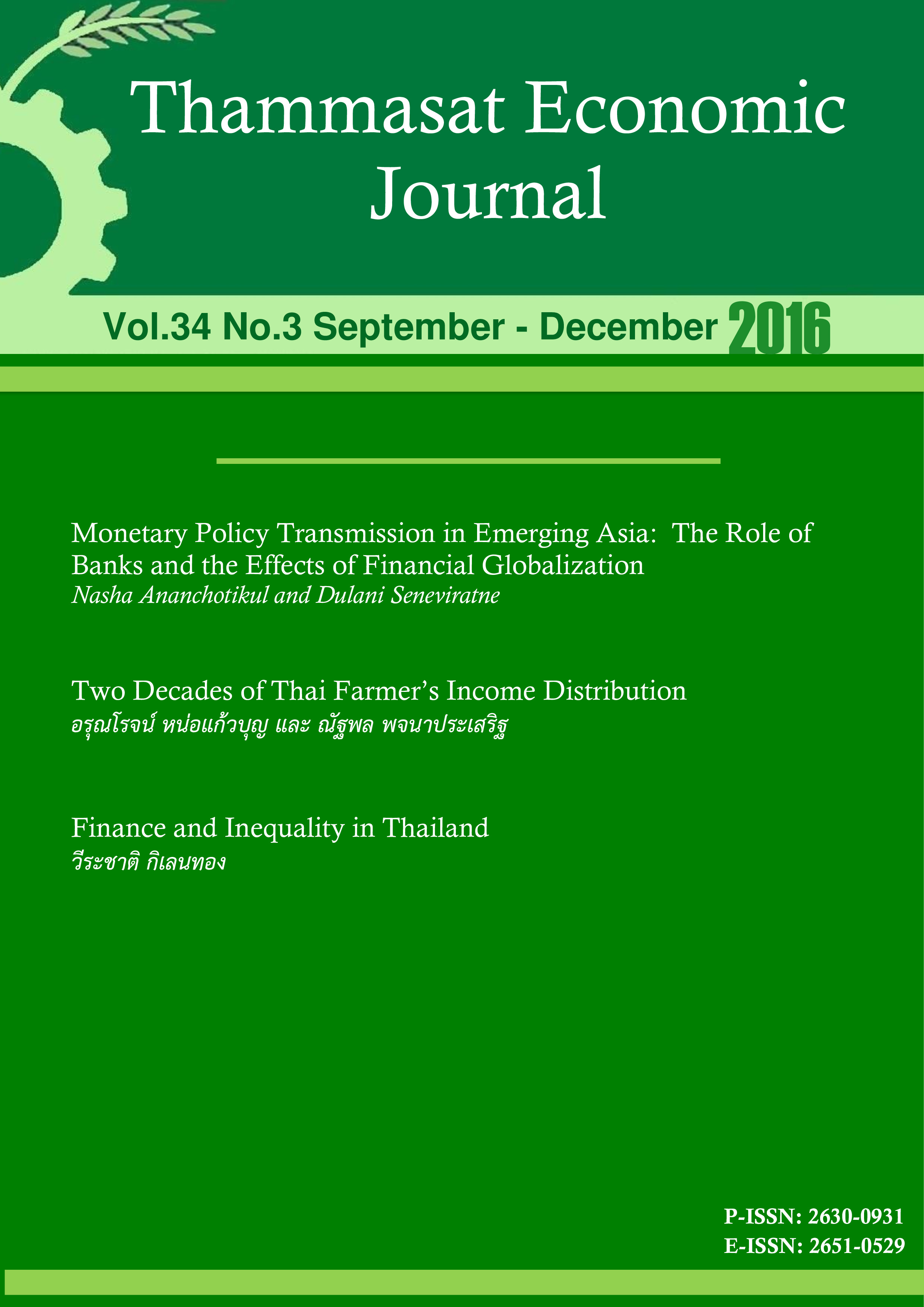Finance and Inequality in Thailand
Keywords:
Inequality, Kuznets' curve, social mobility, formal financial access, borrowing constraints, risk managementAbstract
Although income inequality within Thailand is considerable, it is not exhibiting any alarming upward trend. On the other hand, consumption inequality has been steadily decreasing over the last decade. The relationship between income inequality and income per-capita corresponds to a Kuznets' curve, which represents an inverted-U shape.The social mobility of Thai households, especially those with formal access to finance, is reasonably high. This paper outlines findings concerning two main mechanisms, risk management and borrowing constraints, through which formal financial access can affect inequality, and provides supporting empirical evidence for the conclusions presented.
References
กอบศักดิ์ ภูตระกูล. (2556). ดุลยภาพของการเจริญเติบโตจากมิติของการกระจายรายได้. เอกสารประกอบการสัมมนาธนาคารแห่งประเทศไทยประจำปี2556. (ม.ป.พ.,ม.ป.ท.).
วีระชาติ กิเลนทอง. (2557). ประสิทธิภาพของการผลิตรวมของประเทศไทยและการเข้าถึงแหล่งเงินทุน.
เศรษฐกิจมหภาคและนโยบายทางเศรษฐกิจของประเทศเล่มที่ 2 บทที่ 3. (ม.ป.พ.,ม.ป.ท.).
Alem, M. and Townsend, R. (2013). Efficiency, Equilibrium, and Asset Pricing with Risk of Default. forthcoming in Journal of Econometrices.
Banerjee, A. and Newman, A. (1993). Occupational choice and the process of development. The Journal of Political Economy, 101 (2): pp. 274-298.
Beck,T., Demirgüç- Kunt, A., and Levine,R. (2007). Finance, inequality and the poor. Journal of economic growth, 12(1): pp. 27--49.
Bianchi,M. and Bobba,M. (2013). Liquidity, risk, and occupational choices. The Review Of Economic Studies, 80(2): pp. 491-511.
Bourguignon, F. (1979). Decomposable income inequality measures. Econometrica,47(4): pp. 901-920.
Clarke,G., Xu,L.C., and Zou,H.-f. (2013). Finance and income inequality: Test of alternative theories. Annals of Economics and Finance,14(2): pp. 491-516.
Evans, D.S. and Jovanovic, B. (1989). An estimated model of entrepreneurial choice under liquidity constraints. The Journal of Political Economy, pp. 808--827.
Fang, Z. and Sakellariou, C. (2013). Evolution of urban--rural living standards inequality in thailand: 1990--2006. Asian Economic Journal, 27(3): pp. 285-306.
Giné, X. and Townsend, R.M. (2004). Evaluation of financial liberalization: a general equilibrium model with constrained occupation choice. Journal of Development Economics, 74(2): pp. 269-307.
Greenwood, J. and Jovanovic, B. (1990). Financial development, growth, and the distribution of income.Journal of Polutscal Economy, 98(5).
Ikemoto, Y. and Uehara, M. (2000). Income inequality and kuznets’ hypothesisin thailand. Asian Economic Journal, 14(4): 421--443.
Jauch, S. and Watzka, S. (2011). Financial development and income inequality. Technical report, CESifo working paper: Fiscal Policy, Macro economics and Growth.
Jeong, H. (2008). Assessment of relationship between growth and inequality: micro evidence from Thailand. Macro economic Dynamics,12(S2): pp. 155--197.
Jeong, H. and Townsend, R. (2007). Sources of tfp growth: Occupational choice and financial deepening. Economic Theory,32(1): pp. 179--221.
Jeong, H. and Townsend, R.M. (2008). Growth and inequality: Model evaluation based on anestimation-calibrationstrategy. Macro economic dynamics,12(S2): pp. 231--284.
Karlan, D, Osei, R.D, Osei-Akoto, I, and Udry, C. (2012). Agricultural decisions after relaxing credit and risk constraints. Technical report, National Bureau of Economic Research.
Keats, A. (2012). Occupational choice inrural kenya: Using subjective expectations data to measure credit and insurance constraints. Technical report.
Kilenthong, W.T. (2014). Financial Access and Risk Bearing Ability of Thai Households. Working Paper.
Kilenthong, W.T. and Rueanthip,K. (2016). Working Paper.
Kinnan, C. and Townsend, R. (2012). Kinship and financial networks, formal financial access, and risk reduction. The American Economic Review,102(3): pp. 289--293.
Kunieda, T., Okada, K., and Shibata, A. (2011). Finance and inequality: How does globalization change the irrelationship? Macro economic Dynamics, pp. 1-38.
Kuznets, S. and Jenks, E. (1953). Shares of Upper Income Groups in Income and Savings. NBER Books.
Lerman, R.I. and Yitzhaki, S. (1985). Income inequality effects by income source: a new approach and applications to the United States. The Review of Economics and Statistics, pp.151--156.
Lloyd-Ellis, H. and Bernhardt, D. (2000). Enterprise, inequality and economic development. Review of Economic Studies, 67(1): pp.147--168.
Motonishi, T. (2006). Why has income inequality in thailand increased?: An analysis using surveys from 1975 to 1998. Japan and the World Economy,18(4): pp. 464--487.
Paulson, A.L. and Townsend, R. (2004). Entrepreneurship and financial constraints in thailand. Journal of Corporate Finance,10(2): pp. 229-262.
Pawasutipaisit, A. and Townsend, R. (2011). Wealth Accumulation and Factors Accounting for Success Journal of Econometrics, 161(1), pp. 56-81.
Paweenawat, S.W. and McNown, R. (2014). The determinants of income inequality in thailand: Asynthetic cohort analysis. Journal of Asian Economics, 31: pp. 10-21.
Piketty, T. and Goldhammer, A. (2014). Capitalin the Twenty-first Century. Harvard University Press.
Ray, D. (1998). Development Economics. Princeton University Press Princeton, NJ.
Rueanthip, K. (2012). The urban-rural income inequality in thailand: 1996-2011.The Economic Science, 60(2): pp. 25-43.
Rueanthip, K., Panpiemras, J. ,and Bisonyabut, N. (2013). Thailand’seconomic growth after 1992: Was that growth pro-poor? TDRI Quarterly Review, 28(3): pp. 3-9.
Sen, A. (1997). On Economic Inequality. Clarend on Press.
Shorrocks, A.F. (1980).The class of additively decomposable inequality measures. Econometrica: Journal of the Econometric Society, pp. 613-625.
Townsend, R. (2011). Financial systems in developing economies: growth, inequality and policy evaluation in Thailand. Oxford University Press.
Townsend, R.M. and Ueda, K. (2006). Financial deepening, inequality, and growth: a model-based quantitative evaluation.The Review of Economic Studies,73(1): pp. 251-293.
Townsend, R.M. and Yaron, J. (2001). The credit risk – contingency system of anasian development bank. ECONOMIC PERSPECTIVES-FEDERAL RESERVE BANK OF CHICAGO, 25(3): pp. 31-48.










